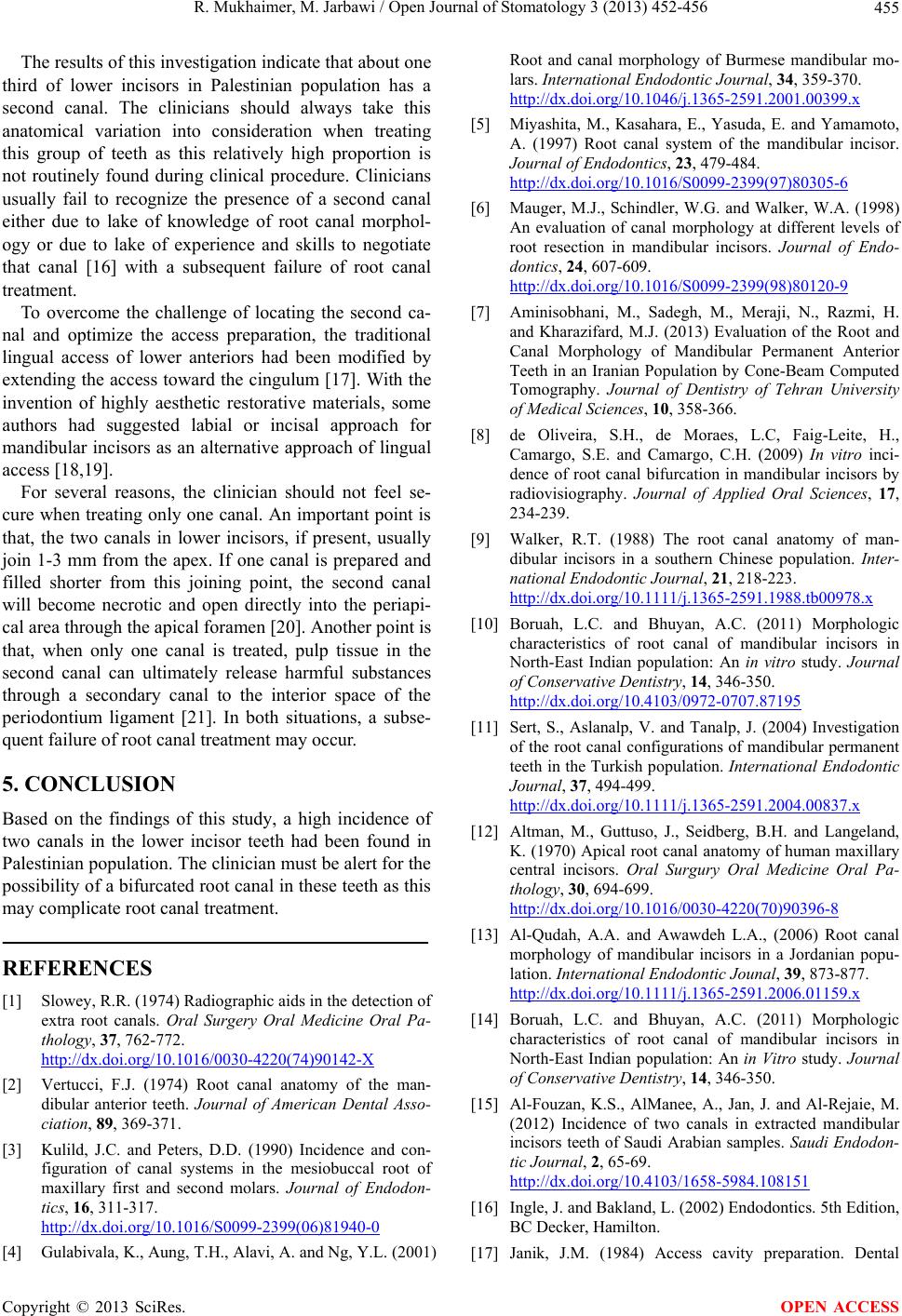
R. Mukhaimer, M. Jarbawi / Open Journal of Stomatology 3 (2013) 452-456 455
The results of this investigation indicate th at about one
third of lower incisors in Palestinian population has a
second canal. The clinicians should always take this
anatomical variation into consideration when treating
this group of teeth as this relatively high proportion is
not routinely found during clinical procedure. Clinicians
usually fail to recognize the presence of a second canal
either due to lake of knowledge of root canal morphol-
ogy or due to lake of experience and skills to negotiate
that canal [16] with a subsequent failure of root canal
treatment.
To overcome the challenge of locating the second ca-
nal and optimize the access preparation, the traditional
lingual access of lower anteriors had been modified by
extending the access toward the cingulum [17]. With the
invention of highly aesthetic restorative materials, some
authors had suggested labial or incisal approach for
mandibular incisors as an alternative approach of lingual
access [18,19].
For several reasons, the clinician should not feel se-
cure when treating only one canal. An important poin t is
that, the two canals in lower incisors, if present, usually
join 1-3 mm from the apex. If one canal is prepared and
filled shorter from this joining point, the second canal
will become necrotic and open directly into the periapi-
cal area through the apical foramen [20]. Another point is
that, when only one canal is treated, pulp tissue in the
second canal can ultimately release harmful substances
through a secondary canal to the interior space of the
periodontium ligament [21]. In both situations, a subse-
quent failure of root canal treatment may occur.
5. CONCLUSION
Based on the findings of this study, a high incidence of
two canals in the lower incisor teeth had been found in
Palestinian population. Th e clinician must be alert for the
possibility of a b ifurcated root canal in these teeth as th is
may complicate root canal treatment.
REFERENCES
[1] Slowey, R.R. (1974) Radiographic aids in the detection of
extra root canals. Oral Surgery Oral Medicine Oral Pa-
thology, 37, 762-772.
http://dx.doi.org/10.1016/0030-4220(74)90142-X
[2] Vertucci, F.J. (1974) Root canal anatomy of the man-
dibular anterior teeth. Journal of American Dental Asso-
ciation, 89, 369-371.
[3] Kulild, J.C. and Peters, D.D. (1990) Incidence and con-
figuration of canal systems in the mesiobuccal root of
maxillary first and second molars. Journal of Endodon-
tics, 16, 311-317.
http://dx.doi.org/10.1016/S0099-2399(06)81940-0
[4] Gulabivala, K., Aung, T.H., Alavi, A. and Ng, Y.L. (2001)
Root and canal morphology of Burmese mandibular mo-
lars. International Endodontic Journal, 34, 359-370.
http://dx.doi.org/10.1046/j.1365-2591.2001.00399.x
[5] Miyashita, M., Kasahara, E., Yasuda, E. and Yamamoto,
A. (1997) Root canal system of the mandibular incisor.
Journal of Endodontics, 23, 479-484.
http://dx.doi.org/10.1016/S0099-2399(97)80305-6
[6] Mauger, M.J., Schindler, W.G. and Walker, W.A. (1998)
An evaluation of canal morphology at different levels of
root resection in mandibular incisors. Journal of Endo-
dontics, 24, 607-609.
http://dx.doi.org/10.1016/S0099-2399(98)80120-9
[7] Aminisobhani, M., Sadegh, M., Meraji, N., Razmi, H.
and Kharazifard, M.J. (2013) Evaluation of the Root and
Canal Morphology of Mandibular Permanent Anterior
Teeth in an Iranian Population by Cone-Beam Computed
Tomography. Journal of Dentistry of Tehran University
of Medical Sciences, 10, 358-366.
[8] de Oliveira, S.H., de Moraes, L.C, Faig-Leite, H.,
Camargo, S.E. and Camargo, C.H. (2009) In vitro inci-
dence of root canal bifurcation in mandibular incisors by
radiovisiography. Journal of Applied Oral Sciences, 17,
234-239.
[9] Walker, R.T. (1988) The root canal anatomy of man-
dibular incisors in a southern Chinese population. Inter-
national Endodontic Journal, 21, 218-223.
http://dx.doi.org/10.1111/j.1365-2591.1988.tb00978.x
[10] Boruah, L.C. and Bhuyan, A.C. (2011) Morphologic
characteristics of root canal of mandibular incisors in
North-East Indian population: An in vitro study. Journal
of Conservative Dentistry, 14, 346-350.
http://dx.doi.org/10.4103/0972-0707.87195
[11] Sert, S., Aslanalp, V. and Tanalp, J. (2004) Investigation
of the root canal configurations of mandibular permanent
teeth in the Turkish population. International Endodontic
Journal, 37, 494-499.
http://dx.doi.org/10.1111/j.1365-2591.2004.00837.x
[12] Altman, M., Guttuso, J., Seidberg, B.H. and Langeland,
K. (1970) Apical root canal anatomy of human maxillary
central incisors. Oral Surgury Oral Medicine Oral Pa-
thology, 30, 694-699.
http://dx.doi.org/10.1016/0030-4220(70)90396-8
[13] Al-Qudah, A.A. and Awawdeh L.A., (2006) Root canal
morphology of mandibular incisors in a Jordanian popu-
lation. International Endodontic Jounal, 39, 873-877.
http://dx.doi.org/10.1111/j.1365-2591.2006.01159.x
[14] Boruah, L.C. and Bhuyan, A.C. (2011) Morphologic
characteristics of root canal of mandibular incisors in
North-East Indian population: An in Vitro study. Journal
of Conservative Dentistry, 14, 346-350.
[15] Al-Fouzan, K.S., AlManee, A., Jan, J. and Al-Rejaie, M.
(2012) Incidence of two canals in extracted mandibular
incisors teeth of Saudi Arabian samples. Saudi Endodon-
tic Journal, 2, 65-69.
http://dx.doi.org/10.4103/1658-5984.108151
[16] Ingle, J. and Bakland, L. (2002) Endodontics. 5th Edition,
BC Decker, Hamilton.
[17] Janik, J.M. (1984) Access cavity preparation. Dental
Copyright © 2013 SciRes. OPEN ACCESS